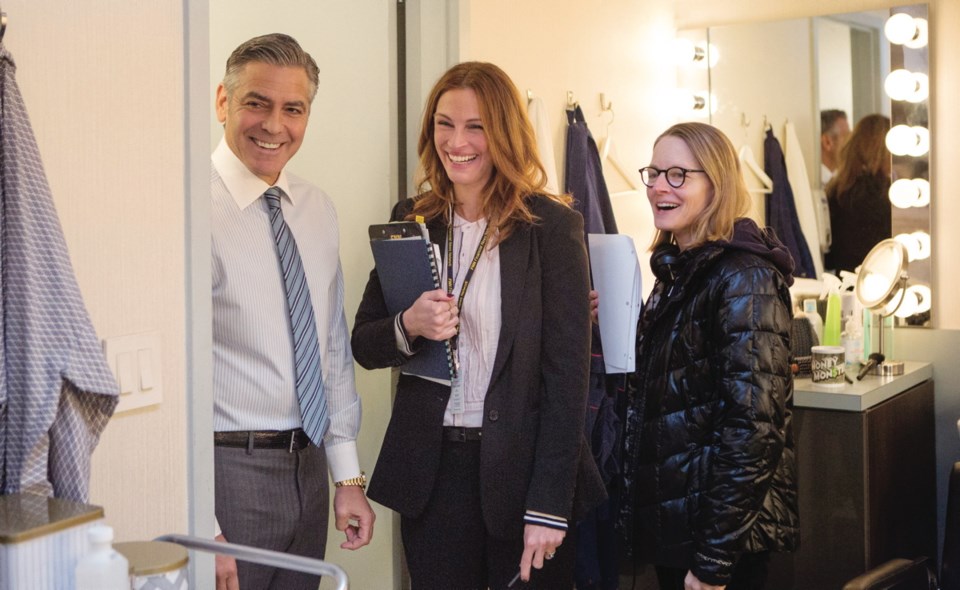What a difference eight years makes. That’s how long it has been since Alan Di Fiore and Jim Kouf wrote the first draft for Money Monster.
Director Jodie Foster’s Wall Street thriller starring George Clooney as an investment guru taken hostage during his TV show by an unhinged investor (Jack McConnell) opens May 13, two days after its première at the Cannes Film Festival. The film reunites Clooney with Ocean’s Eleven co-star Julia Roberts, and features Dominic West as a smarmy CEO.
“It’s a long road to get a movie made,” said Di Fiore, who before going Hollywood 25 years ago, co-founded Pagliacci’s restaurant in Victoria and ran two popular eateries, Grand Central Café and South Side Pizza.
“We wrote it just before the s--- hit the fan as far as the financial world went.”
Money Monster arrives on the heels of several projects about the evils of investment banking, including The Big Short and the Showtime hit Billions.
“Our original concept was more farcical, more like an homage to Network, because it’s almost the same kind of world,” recalled Di Fiore. “It always had thriller elements, but in the process of going to different directors we shaded it more towards that, and by the time it got done, we were both working on Grimm [NBC’s supernatural drama series].”
After producer Daniel Dubiecki (Up in the Air) took a shine to their script, directors including Paul Greengrass considered it before Dubiecki took the project to Foster.
“Once Jodie got interested, George got interested because Dan knew George, and George brought on other people and there you go. Bob’s your uncle.”
Since Di Fiore’s financial references in the script had become outdated, Jamie Linden (We Are Marshall) was brought in to update them.
“What often happens is you turn a feature script over and never see it again,” Di Fiore said. “They bring in a bunch of writers and before you know it, it’s not yours anymore. But Jamie did a great job of pumping it up.”
Di Fiore admits it was a thrill meeting Clooney, who was inseparable from his longtime pal and production partner Grant Heslov (Argo).
“George is a solid guy,” Di Fiore said. “You get that impression immediately, that he’s there for work and he knows what he’s doing.”
He was also struck by how focused Foster was.
“She’s a really cool person, really smart, the best,” Di Fiore said.
Money Monster was the second feature script Di Fiore wrote with Kouf (Stakeout), whom he met while working on the CBS series The Handler.
They also co-wrote A Fork in the Road, a caper comedy starring Sin City’s Jaime King they filmed in Montana.
Di Fiore has grown most accustomed to writing for television, however.
It began in 1982 when he met Stuart Margolin, best known for playing James Garner’s sidekick, Angel, on The Rockford Files, at Pagliacci’s while the actor-filmmaker was here to shoot The Glitter Dome.
Di Fiore began working as story editor and co-writer on Margolin’s projects, including Mom P.I. He also worked on the mini-series Vendetta; was head writer for Canadian producer Chris Haddock’s hit crime series DaVinci’s Inquest; wrote the CTV movie The Life of David Milgaard and episodes of The Handler, Neon Rider, Ghost Whisperer and The Bridge.
“Film is a director’s medium, whereas TV is a writer’s medium,” said the Ohio-born wordsmith. “It’s so different from TV where I’m boss,” he said with a laugh. “In the movies it’s: ‘Oh, who you are you again? Oh, yeah, go sit over there.’ ”
To succeed in show business, you can’t afford to be egocentric, Di Fiore says.
“You can’t be precious about your work. The way it has to work is that the best idea is the idea that needs to come out of the [writers’] room.”
He said Grimm, the cop drama inspired by Grimm’s Fairy Tales, was fulfilling in part because “it’s fun” writing horror.
“You have to find a creature of the week, basically, and at the same time you’re telling a long-term story.”
With networks leaning toward 13-episode seasons and doing fewer reruns, the residual payments many writers once lived on are dwindling, but new venues such as Netflix are providing more gigs, he said.
“I prefer TV because you write it and two weeks later they’re making it,” said Di Fiore, who likes that TV is more character-driven and reaches a larger audience.
“You could write a feature and 200,000 people or a million will see it, and if you write a TV show like Grimm, you’ll do five million viewers a week. That’s pretty cool.”
Di Fiore is writing an episode for an eight-part series, The Long Road Home for National Geographic Channel. It’s based on ABC White House correspondent Martha Raddatz’s book chronicling a firefight in 2004 in Sadr City that marked the beginning of the Iraqi insurgency, and its impact on a platoon of American soldiers and their families.
“It’s a real honour,” Di Fiore said. “It’s like someone said: ‘Do you want to write Band of Brothers?’ What are you going to say? No?”
